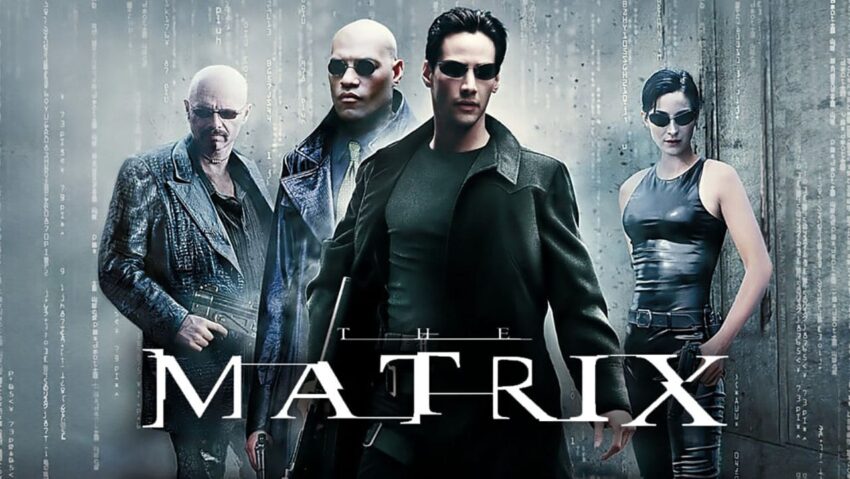The Syd Field Paradigm is a template of narrative structure used to write screenplays. According to its creator, every screenplay should be written following this three-act structure. As he himself says “Screenplays that work follow the Paradigm. Don’t take my word for it. Go to a movie and see whether you can determine its structure”. Below, there is the analysis of the movie Matrix. It was released in 1999 and directed by Andy and Larry Wachowski with Keanu Reeves, Laurence Fishburne and Carrie-Anne Moss in the role of the protagonists respectively Neo, Morpheus and Trinity.

FIRST ACT

The movie opens with an action sequence where a black dressed woman fights against four or more policeman, all armed and dreed with bulletproof suit. She’s Trinity, one of the protagonists, who with agile and captivating movements manages to escape. We follow her jumping from roof to roof, from building to building, careless of the gravity, escaping from the Sentient agents. She literally flies in the air, then on foot she surpasses a truck heading to a phone box where the telephone is ringing. She can reach the telephone, grabs it just before the truck crashes on the phone box.
So, We don’t have enough information yet to understand. We don’t know who Trinity is, if she one of the “good guys” or the “bad guys”. We don’t know what’s the story is about, how it will develop or who is the main protagonist.
What is the Matrix?
Thomas Anderson, called Neo, is introduced as an hacker and an office worker who is searching some answers, or better who can give them to him, about Matrix, that is Morpheus.
Trinity meets Neo at a club while he is searching for Morpheus and she warns him that he is in danger. “You’re in danger. I brought you here to warn you. They’re watching you Neo.” she tells him. She knows exactly what he is looking for and she adds “the answer is looking for you and it will find you, if you wanted to”. Then she’s gone.

Later we find out the all of us are in a parallel universe and that Matrix is a virtual reality, an illusion, that human beings have been programmed to accept. The real world has been recreated by a race of machines called AI (Artificial Intelligence).
Morpheus is committed to fight against Matrix in order to reveal the truth and free the humanity form the machines control. The hope of those who fight like him is to find “The One”, a human being with godlike powers who will lead them in the final battle.
Morpheus believes that Neo is “The One”.
At work Neo receive a package containing a phone, it rings and on the other side there’s Morpheus. Morpheus warns him that the Agents are coming and that he has only two ways to get out of the building: from the window hundred metres high or with them. Neo has to choose.
The choice is a recurring theme in the movie and it is important. Neo is like Hamlet; he represents the architype of the reluctant hero who is called for a mission. In order to complete it, he has to choose, he has to become aware and above all he has to accept his role and his destiny.
At this point, the premises of the story has been set, the characters have been introduced and information has been given to understand the initial situation.
The first act end with Neo meeting Morpheus.
FIRST PLOT POINT AND FIRST PINCH

Neo and Morpheus meet and the protagonist has to choose once again. This choice is the first plot point of the narration. Here is the iconic scene of the pills.
“Unfortunately, no one can be told what the matrix is. You have to see it for yourself. This is your last chance, after this there is no turning back. You take the blue pill, the story ends, you wake up in your bed and believe whatever you want to believe. You take the red pill; you stay in Wonderland and I show you how deep is the rabbit hole goes”.
Blue pills to come back to the ordinary world, red pill for the truth. Neo take without hesitation the red one and in this way, he starts his journey to reborn. Neo’s choice to finding the truth is the first pinch that makes story moving on.
SECOND ACT

Mind and body are linked but they also are separate entities. Controlling the mind means controlling the reality and our own destiny. Neo has to learn this and to do it he has to train both his mind and his body. Thanks to a computer program, he learns martial arts and gets new abilities.
However, what’s important for him to learn is to free his mind from the limits within which it was used to live. Once he’d have learned that he will be able to be his true self and he will be able to use his infinite potential but above all he will be able to understand that being “The One” is his choice.
Neo’s training takes up all this second act.
Once the training is completed, Morpheus takes Neo to the Oracle.
POINT OF NO RETURN AND SECOND PINCH

Neo meeting with the Oracle is the point of no return in the story. The character of the Oracle, played by Gloria Foster, is not what the audience can expect. You can expect it to be an old wise man with a long white beard but it’s not like that. The Oracle is introduced as an old kind woman cooking biscuits.
She knows that neo doubts of himself. “I’m just an ordinary guy” he says indeed and this shows that his mind is still limited. The Oracle is a mirror, she reflects what Neo thinks and he does not believe to be “The One” but Morpheus does.
“Morpheus believes in you Neo and no one not you not even me can convince him otherwise. He believes it so blindly that he’ going to sacrifice his life to save yours”
The Oracle warns Neo that he is going to have to make a choice, he will have to choose between his own life and Morpheus’s one. “One of you is going to die, which one will be up to you” she tells him. Basically, what she is telling him and she has told him from the beginning is that he is the one who can know if he is “The One” or not, he is the one who can choose.
The oracle’s prophecy comes true, Morpheus attacks the Agents to save Neo and he gets captured. This action is the second pinch of the story.
SECOND PLOT POINT

Neo decides to save Morpheus and with Trinity attacks the Agents. Here is another iconic scene, that of Neo who dodges the bullets in slow-moving.
Neo manages to save Morpheus. He and Trinity get out from Matrix but Neo gets attacked by Agent Smith. There’s a long and hard battle between them where neo gets defeated and dies.
THIRD ACT

Neo lies lifeless on the chair while Trinity whisper him what the Oracle has told her.
“The Oracle told me I will fall in love with a man and the man I will love would be the one. So, you see, you can’t be death, you can’t be because I love you”
It is said that love is the most powerful force, able to overcome any obstacle and limit, even death. Love is so strong to keep living in the minds and the hearts of people, it never dies.
So, Trinity’s love brings Neo alive, no matter how, but “The One” stand up again and come fighting.
Unforgettable and iconic is also this scene here of Neo who stops the bullets with his mind.

Finally, Neo has accepted his role, he is reborn, his mind his free now. He defeats the Agent Smith, played by Hugo Weaving, who gets destroyed. He is the virtual representation of the machines that control the real world.
“I know you are out there. I can feel you know. I know that you are afraid, afraid of us. You are afraid of change. I don’t know the future; I didn’t come to tell you how this is going to end. I came here to tell you how this is going to begin. I’m going to hang up this phone and I’m going to show this people what you don’t want them to see. I’m going to show them the world, without you. A world without rules and controls, without borders or bounders. A world where everything is possible.”
This is what Neo says at the end of the movie before taking flight in the middle of a crowd of people.
CONCLUSION
Matrix is one of the most iconic movies ever realized. It’s a milestone in the field of action and fanta-scientific movies. It makes us think about the human condition and its relationship with the technology.
It is one of the many movies that can be analysed with the Syd Field Paradigm.
On the official website of the screenwriter, you can find many other examples like this, indeed he believed that every screenplay followed his template.
As I said at the beginning of the article and as I explained in the relative article, this type of narrative structure can be used to write screenplays but also other types of stories.
At this link you can find the analysis of a commercial realized with the Syd Field Paradigm as a practical example.

